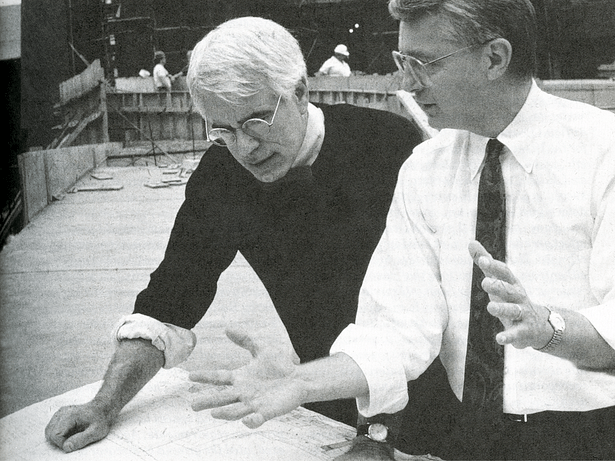
Columbus, OH

In their competition submission for a new Center for Visual Arts on the Ohio State University campus, Richard W. Trott (BARCH ’61) and Peter Eisenman proposed a new east/west axis into the campus. They considered this new crossing to be not just a route but an ‘event,’ which would define “the intersection of the university grid with the city grid, and thus symbolize[s] the intersection of the arts with the community.” Trott’s distinguished career as an architect and his formal training in the discipline forms yet another intersection of campus and city, connecting his studies as an Ohio State architecture student and the buildings he later designed in Columbus, Ohio.
Twenty-eight years before the opening of the Wexner Center for the Arts, Trott was completing his Schiller Square, German Village project (see below) in his senior year at the Ohio State School of Architecture (now called the Austin E. Knowlton School of Architecture). His design studio instructor, Richard A. Miller, FAIA, a visiting professor in 1960-61, focused his students’ work on the near-south side of downtown Columbus. The resulting studio project was credited as a significant impetus for the subsequent development of the renovation of German Village. After graduating in 1961, Trott attended the University of Minnesota under Ralph Rapson, where he received his master’s degree in Architecture in 1963.
After completing his degree programs, Trott returned to Columbus where he joined a group of young designers in David Schackne’s (BARCH ’51) Columbus Public Schools’ architectural office. He later began his own practice in partnership with Jim Bean, whose early work included the design for Leslie Wexner’s first women’s clothing store, The Limited, in Kingsdale Shopping Center.
Following the announcement of the Ohio State visual arts center competition in 1983, Jerry Voss introduced his former college roommate, Peter Eisenman, to Richard Trott. At the time, Voss was the Director of the Ohio State School of Architecture, and Trott’s practice, Trott & Bean, was distinguished in Columbus for its design excellence. Eisenman commented on the collaboration: “Together we struck a 50-50 deal, which later became a true friendship. There is no doubt that Trott brought a local historical perspective and interpretation to the design and construction that ensured the lasting success of the project. The rest is history.”
The design produced by Eisenman and Trott won the international competition. In contrast to the neoclassical buildings that populated the campus oval, the 180,000-square-foot center envisioned by Eisenman and Trott sought a redefinition of space in the aid of showcasing contemporary and experimental artwork. The Center’s envelope combined a red brick, fortress-like tower – evoking the former armory located on the west edge of the site – and a three-dimensional white grid work extending through and beyond the building mass. The overlapping of two grids, one representing the city, and the other representing the campus, allowed the building to serve as the nexus of the grids’ formal resolution.
In addition to the Wexner Center for the Arts (1989), at the time considered Ohio State’s most daring building, Trott and partners designed over forty major completed buildings for a variety of commercial, residential and institutional uses. “His was one of the most avant-garde design firms in Columbus. Without question, Dick was a mover and shaker in the architectural community,” recalled Robert Livesey. Notable buildings include the Sherex Chemical Company Building (1982), the 77 East Nationwide Boulevard (Renovation, 1984) the 500 South Front Street Building (1990) and the Greater Columbus Convention Center (1993), in which he again collaborated with Peter Eisenman.
Trott’s career was characterized by a receptiveness to new, and even radical, ideas that sought to integrate the arts and design in numerous award-winning buildings. He was recognized with a Governor’s Award for Contributions to the Fine Arts and was elected to the College of Fellows of the American Institute of Architects.
Following his passing in 1990, Richard W. Trott’s family honored his legacy by creating the Richard W. Trott ’61 Distinguished Visiting Professorship in 1991. The professorship brings internationally acclaimed architects, landscape architects and planners to the Knowlton School, where they teach design studios, conduct seminars and make a public school presentation. “It’s one of the strengths of the school,” commented Robert Livesey. “The Knowlton School brings the world of architecture, landscape architecture, and planning to its students. One of the ways we do this is through the Trott Distinguished Visiting Professorship. It is essential to the character and quality of the education we provide.”
In its over twenty-six years of enriching the educational experience of Knowlton School students, the Trott Professorship has brought in acclaimed visiting theorists and practitioners such as: Roland Gustavvson (2015-16), Curtis Roth (2012-13), Amale Andraos (2006-07), Robert Somol (2003-04), Timothy Beatley (2001-02) and Peter O’Shea (1999-00).
Richard W. Trott’s legacy not only endures in the buildings that stand in the Columbus cityscape and on the Ohio State campus; it is also embedded in the efforts of Knowlton School architecture, landscape architecture and planning students still to be envisioned.
No Comments
Block this user
Are you sure you want to block this user and hide all related comments throughout the site?
Archinect
This is your first comment on Archinect. Your comment will be visible once approved.